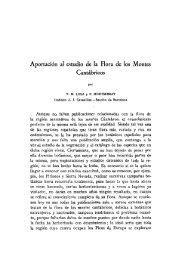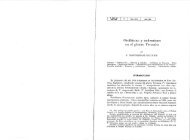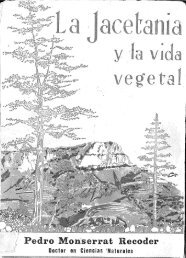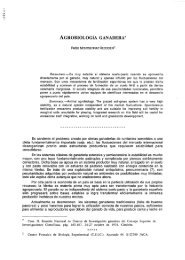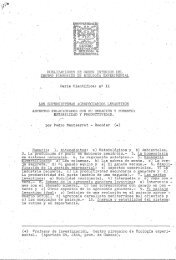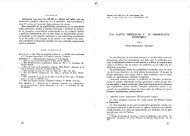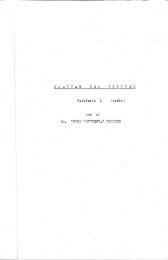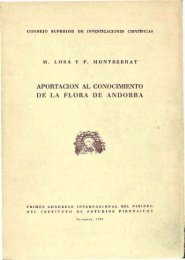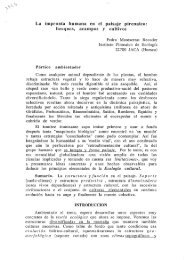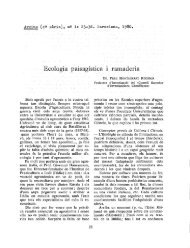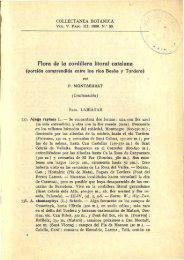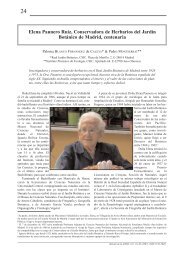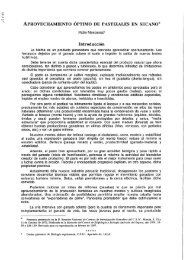the systems of grassland management in spain - Publicaciones del ...
the systems of grassland management in spain - Publicaciones del ...
the systems of grassland management in spain - Publicaciones del ...
You also want an ePaper? Increase the reach of your titles
YUMPU automatically turns print PDFs into web optimized ePapers that Google loves.
56However, nowadays <strong>the</strong> autumn graz<strong>in</strong>g <strong>of</strong> acornsby pigs (montanera) has disappeared and <strong>the</strong> lachasheep are graz<strong>in</strong>g all <strong>the</strong> year <strong>in</strong> foresl and serubs,loge<strong>the</strong>r wilh an <strong>in</strong>ereas<strong>in</strong>g number <strong>of</strong> horses. Thepony (jaca navarra) is also typieal <strong>of</strong> lhis landseape.Al lhe present time, <strong>the</strong> more <strong>in</strong>tensified agrieullureis limited to <strong>the</strong> deep vaIley soHs, but <strong>the</strong> fieldsare aIways surrounded by hedges, shrubs and trees,ma<strong>in</strong>ly relicts fram <strong>the</strong> anclent forests. Permanent<strong>grassland</strong>s are dom<strong>in</strong>ant on slopes, situated bolow<strong>the</strong> grazed forests.Pastures with Brachypodium p<strong>in</strong>natum dom<strong>in</strong>anl,togelher with Erica vagans or braeken(Pteridium aquil<strong>in</strong>um) show bad graz<strong>in</strong>g teehniques<strong>in</strong> lhis landseape, promoted by <strong>the</strong> abandonmeut<strong>of</strong>marg<strong>in</strong>allands. Ecological diversity is favour<strong>in</strong>ggraz<strong>in</strong>g husbandry <strong>in</strong> this attractive part <strong>of</strong> Spa<strong>in</strong>.The communal organizalion and o<strong>the</strong>r historieal<strong>in</strong>fluences, toge<strong>the</strong>r with an improved road system,will be helpful <strong>in</strong> improv<strong>in</strong>g a new animalhusbandry.Aragón (2b <strong>in</strong> Fig. 3.10)The boa/m·es. The villages <strong>of</strong> lhe HuescaPyrenees, like many o<strong>the</strong>r agrieultural prov<strong>in</strong>ees <strong>of</strong>Spa<strong>in</strong>, reta<strong>in</strong>ed sorne plots <strong>of</strong> forest from lhecommunal property. Traditionally <strong>the</strong>se plols weregrazed by traetÍon animals (oxen, horses, mulesand donkeys). They are ealled dehesa boyal, boveral01' boalar, mean<strong>in</strong>g a surface reserved fOI oxeo. Thedom<strong>in</strong>ant tree is a local oak or quejigo (manyslra<strong>in</strong>s <strong>of</strong>Q.fag<strong>in</strong>ea) or <strong>in</strong> <strong>the</strong> more Mediterraneanpart lhe evergreen oak (Q. ilex subsp. I"Otundifolia).Until recent times (1940-1960) shrubs were verysparse under <strong>the</strong> trees, and were elim<strong>in</strong>ated byheavy graz<strong>in</strong>g, but s<strong>in</strong>ce <strong>the</strong> use <strong>of</strong> mechanicflltraetors has become frequent, this special <strong>grassland</strong>has evolved towards a natural forest.Every hamlet <strong>in</strong> this part <strong>of</strong> <strong>the</strong> Pyrenees has itsown boalar wilh an area <strong>of</strong> 2 to 10 ha accord<strong>in</strong>g to<strong>the</strong> exigences <strong>of</strong> plough<strong>in</strong>g. Under this very sunnyclimale, good <strong>grassland</strong> can be proteeted by acanopy screen <strong>of</strong> pruned trees. Animal dung andur<strong>in</strong>e ereate good eonditions for grass under heavygraz<strong>in</strong>g pressure. This special sod and very produetivelurf should be used <strong>in</strong> <strong>the</strong> future todiversify <strong>the</strong> <strong>grassland</strong> <strong>in</strong> every mounla<strong>in</strong> village,ma<strong>in</strong>ly because it is aeeessible and well adapted tograzmg.PEDRO MONTSERRAT aud FEDERICO FILLATDevelopmenl <strong>of</strong> meadows from fields <strong>of</strong> sa<strong>in</strong>fo<strong>in</strong>and lucerne. Same characteristics <strong>of</strong> mounta<strong>in</strong>meadows are summarized <strong>in</strong> Fig. 3.13. The graph(Fig.3.13c) expla<strong>in</strong>s two importanl effects onquality <strong>of</strong> meadows. The ord<strong>in</strong>ate axis is a quality<strong>in</strong>dex for <strong>the</strong> firsl eul [DNDF~Digestibility <strong>of</strong> <strong>the</strong>eeIl-wall material (neutro-detergent fibre - Goer<strong>in</strong>gand Van Soesl, 1970-)] and <strong>the</strong> abseissa <strong>the</strong>eutt<strong>in</strong>g date. The oeeanic type <strong>of</strong> climate <strong>of</strong> <strong>the</strong>more westerly sites (Hecho and Siresa) wilh amilder spr<strong>in</strong>g faeilitate an early cut as camparedwith Anciles and Cerler. The hay quality is betterat lower (Hecho, 833 m) than al higher altitude(Siresa, 1050 m), and <strong>the</strong> same is lrue <strong>in</strong> <strong>the</strong>eomparison belween Anciles (1200 m) and Cerler(1500 m) <strong>in</strong> <strong>the</strong> easlern Alto Aragón.Table 3.1 shows <strong>the</strong> location <strong>of</strong> eight sampl<strong>in</strong>gsiles on present-day <strong>grassland</strong>: sorne <strong>of</strong> <strong>the</strong>m arecom<strong>in</strong>g from old fields (2, 3 and 5), o<strong>the</strong>rs fromlucerne fields (1 and 4) and f<strong>in</strong>ally one comesdireetly from a cleared foresl (8). In <strong>the</strong> lasl yearssome fieIds were sown with selecled <strong>grassland</strong> seed(6 and 7). In general, we can see lhe height <strong>of</strong>grasses and <strong>the</strong> stabilization <strong>of</strong> legumes at lowlevels.Table 3.2 summarizes <strong>the</strong> total production(eutt<strong>in</strong>g and graz<strong>in</strong>g) <strong>of</strong> a typieal meadow <strong>of</strong> lhisreglOll.Table 3.1 emphasizes <strong>the</strong> effeet <strong>of</strong> manur<strong>in</strong>g onlhe first cut (June 1977) under diversified eondi'tions <strong>of</strong> mounta<strong>in</strong>s. Lucerne rema<strong>in</strong>s many yearstoge<strong>the</strong>r with new-com<strong>in</strong>g spontaneous species,and ma<strong>in</strong>ta<strong>in</strong>s fertility <strong>in</strong> <strong>the</strong> topsoi!. In <strong>the</strong> sameway, sa<strong>in</strong>fo<strong>in</strong> improved soil ferlilily on dry slopeson limes tone. In order to establish new meadows, itwill be essential to use adapted legumes and grasseslike eoeksfoot (Dactylis glomerata) or o<strong>the</strong>r seleetedseeds, always wilh heavy manur<strong>in</strong>g.Thc borda for hay and animals. In <strong>the</strong> SpanishPyrenees, bordas are not very frequent except <strong>in</strong> <strong>the</strong>cenlral region where <strong>the</strong> big valleys are suitable forimportant hay produetion. Figure 3. 14C shows <strong>the</strong>big dissimilarily between lhe easlern and westernsides <strong>of</strong> <strong>the</strong> Monte Perdido, <strong>in</strong> lhe centre <strong>of</strong> thisseelion. The Aneient Pyrenees (<strong>of</strong> Primary orPalaeozoie age) are more important lo lhe east,while <strong>the</strong> Sierras Interiores (more reeent, <strong>of</strong>Oligocene age) are predom<strong>in</strong>ant <strong>in</strong> lhe west;consequently, <strong>the</strong> big valleys are frequenl <strong>in</strong> <strong>the</strong>east. The altitud<strong>in</strong>al distribution <strong>of</strong> bordas is



